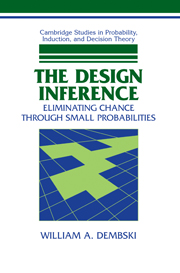2 - Overview of the design inference
Published online by Cambridge University Press: 06 July 2010
Summary
THE EXPLANATORY FILTER
Whenever explaining an event, we must choose from three competing modes of explanation. These are regularity, chance, and design. To attribute an event to a regularity is to say that the event will (almost) always happen. To attribute an event to chance is to say that probabilities characterize the occurrence of the event, but are also compatible with some other event happening. To attribute an event to design is to say that it cannot reasonably be referred to either regularity or chance. Defining design as the set-theoretic complement of the disjunction regularity-or-chance guarantees that the three modes of explanation are mutually exclusive and exhaustive. It remains to show that design is significant in its own right.
The principal advantage of characterizing design as the complement of regularity and chance is that it avoids committing itself to a doctrine of intelligent agency. In practice, when we eliminate regularity and chance, we typically do end up with an intelligent agent. Thus, in practice, to infer design is typically to end up with a “designer” in the classical sense. Nevertheless, it is useful to separate design from theories of intelligence and intelligent agency. An intelligence may, after all, act to mimic regularity or chance, and thereby render its actions indistinguishable from regularity or chance (cf. the discussion of cryptography and randomness in Sections 1.6 and 1.7). Anything might have an intelligent cause.
- Type
- Chapter
- Information
- The Design InferenceEliminating Chance through Small Probabilities, pp. 36 - 66Publisher: Cambridge University PressPrint publication year: 1998



